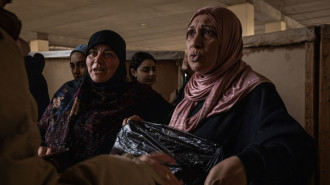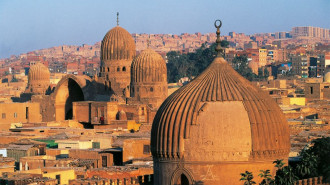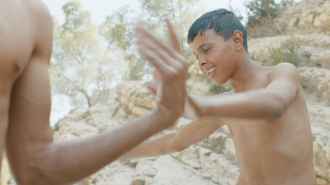
Sana Murrani's intimate archive 'Ruptured Domesticity' maps memories of Iraqi refuge

Sana Murrani, like any other Iraqi, didn’t intend on leaving her home.
She graduated from her Masters in Architecture from Baghdad University a week before the invasion in March 2003 and she had the opportunity to study in London in June that year for her PhD.
So after finishing, she took up a permanent position at the University of Plymouth as a lecturer in architecture. “I left family behind,” she tells me over Zoom. “But since then, they have also left, right at the beginning of the sectarian violence.”
"This mapping of memories draws on the material archive – an access point for map-building and giving voice to trauma without replaying pain"
No longer a practising architect, Dr Murrani now works as a full-time academic and is the founder of the Displacement Studies Research Network and co-founder of Justice and Imagination in Global Displacement.
For the last seven to 10 years, she’s been working with refugees and people who are displaced in Europe, “trying to understand how we can start to come to terms with the loss of home and new meanings of home in the diaspora.”
Sixteen months ago, the Associate Professor in Spatial Practice started writing a book, Ruptured Domesticity: Mapping Spaces of Refuge in Iraq, the first book by an Iraqi written about spatial practice which acted as the catalyst for her latest exhibition of the same name.
The exhibition is the sum of a deep mapping and thematic analysis of fifteen interviews with Iraqis from across the country. The interviews were thematically analysed and visually mapped, and the exhibition is associated with a digital archive of the maps which was launched online on the eve of the 20th anniversary of the US-led Invasion of Iraq in March 2023.
According to Brown University, the 2003 U.S. invasion displaced approximately one in 25 Iraqis from their homes, and as of 2020, 9.2 million Iraqis are internally displaced or refugees abroad.
For Murrani, this reality means facing up to “longing for a home that you can't return back to”. Her motivations behind the exhibition stemmed from a fascination with maps and her use of them as a coping mechanism whilst in Iraq. “I used to draw these maps in my head to try and escape and think how I'm going to leave," she reveals to me.
Using memory work is “another way of understanding how we come to terms with the reality that we're living in right now. And how we engage with ideas around identity and belonging,” she continues. Any Iraqi, or child of Iraqi immigrants, knows the weight of memory well.
Nostalgia for the pre-war era can be burdensome and for Murrani, she’s eager to allow Iraqis to play out their spaces of refuge in order to move beyond imagined sanctuary into something more tangible.
|
These maps “aren’t the kind of maps you see on Google Maps”, they’re iterative, Dr Murrani explains to me, meaning she had to go back and forth tracing and drawing and retracing and collaging – whilst there is clearly an artistic process present, the main goal was to translate the 15 interviews which came from all across Iraq, “from top to bottom, from North to South, into visual content."
At LSE stands the 90-metre-long wall full of maps of the same size, presented along with a description of what the map is illustrating and a quote by the person who the map represents.
The idea, explains the academic, “is to map the journeys that [the interviewees have] taken to escape violence and war."
What is also depicted on the maps are particular moments of trauma that the Iraqi participants spoke about which Dr. Murrani then transformed into a three-dimensional model, which are housed within glass cabinets that stand opposite the main wall.
In order to create the map works, Murrani ‘flattens’ the interviews; she physically prints all collected material out and thematically scans them, picking overlapping points between interviews.
Murrani focused on elements in the interviews like material culture, the home, the urban, and mobility. “I also picked displacement in general and how many movements they've done… which I call ruptures.” These ruptures then get laid out and colour coded. “In the exhibition, it's more flat, but when I write in the book, and I talk about the material culture, and how many people, for example, had mentioned objects that meant a sense of refuge for them.”
The participants mentioned items from the Quran to prayer beads, some of them mentioned blankets, books, “or their notebook that they wrote all of their secrets.”
This mapping of memories draws on the material archive – an access point for map-building and giving voice to trauma without replaying pain.
Murrani was keen to focus on the journeys that the participants spoke about and she would find the major trauma which she would turn into intricate three-dimensional (or 2D-and-a-half, as she calls them) models.
“It's intentional that they were made out of very thin card because it gives that flimsiness to the fragility of that moment.” The drawings of the maps of the cities came from an open source software, which she would then collage using Photoshop.
It was important for Murrani to amplify not only marginalised voices within Iraq but also to represent Iraq as much as possible – this was part of “giving back” to her country with authenticity and sincerity.
She intentionally made choices to amplify more female voices than male voices within the exhibition, and she had at least two people from each part of Iraq which she chose to highlight – including Basra and Sinjar – to give different viewpoints of the same area.
A man and a woman, one from the south and one from the north of Sinjar, for example, told Murrani how when ISIS came, they invaded from the south, so that the south had very little time to do what the north had already done to protect themselves.
Some from the south just managed to escape and embarked on a more difficult journey of escape. This resulted in the two participants recalling very different journeys of seeking refuge despite being from the same city.
"The Arab region in general, but especially Iraq, is weighted under a Western pedagogy that prescribes a crumbling waste-land to its future, but also weighted under the reality of a climate crisis and lack of safe physical infrastructure"
Amaan – ‘safe’ in Arabic – is the word centred in a photograph of graffiti taken in Mosul in 2019 and which is presented in the exhibition. The word was branded on houses in the area by the demining team who were going around the houses to demine and mark them as safe to enter or not. “Those houses are still locked, and people are still scared to go back”.
Murrani explains to me that she included this image in order to remind her audience that Iraq’s instability is not simply defined by 2003, but by the 20 years that followed, and which continues till today.
Iraq is still struggling with deadly pollution, and staggering rates of birth defects, cancer, infant mortality, lack of access to clean water and lack of stable electricity. The second biggest oil field in the world sits in Rumaila, for example, as is killing the children who live within its poisonous reach, such as the recent passing of 19-year-old Ali who was featured in the BBC documentary, Under Poisoned Skies.
|
The Arab region in general, but especially Iraq, is weighted under a Western pedagogy that prescribes a crumbling waste-land to its future, but also weighted under the reality of a climate crisis and lack of safe physical infrastructure.
To imagine spaces and architectures that can sustain life and keep it Amaan in the region is to exercise radical imagination.
A more unexpected outcome of the exhibition was the empathetic links created across regions impacted by conflict trauma around the world, generating an understanding that “violence and war comes and goes, but actually, trauma lingers and stays with you”, says Murrani.
“Understanding that those people are still fragile 20 years on is really important. And I think it's important in the context of what's going on across the Middle East at the moment and the rest of the world.”
Now, Murrani is keen to continue creating knowledge by non-Westerners about “that part of the world” – Iraq and the surrounding region – looking forward to the publication of her book with Bloomsbury next year.
Although the exhibition and the ongoing project of Ruptured Domesticity seem to recount traumatic events, the aftertaste of experiencing the project is that of hope; according to the UN, nearly 90% of those who left Mosul after the 2019 defeat of ISIS has returned.
After 638 schools reopened – a third of which have been repaired – more than half a million school children returned to education. The hope that spaces of refuge might start to materialise for Iraqis as they have done so for many of the refugees who fled, for those Iraqis who stayed, and for those 4.9 million who returned home, endures.
Dalia Al-Dujaili is the Digital Editor of Azeema, Founder of The Road to Nowhere, a columnist at This Orient, and a freelance journalist with bylines in the Guardian, Huck, Cosmopolitan Middle East, Trippin', Notion and more. She also works with organisations such as Counterpoints Arts and Migrant Rights Network.
Follow her on Instagram: @dalia.aldu


![Palestinians mourned the victims of an Israeli strike on Deir al-Balah [Getty]](/sites/default/files/styles/image_684x385/public/2024-11/GettyImages-2182362043.jpg?h=199d8c1f&itok=xSHZFbmc)


![The law could be enforced against teachers without prior notice [Getty]](/sites/default/files/styles/image_684x385/public/2178740715.jpeg?h=a5f2f23a&itok=hnqrCS4x)
 Follow the Middle East's top stories in English at The New Arab on Google News
Follow the Middle East's top stories in English at The New Arab on Google News


